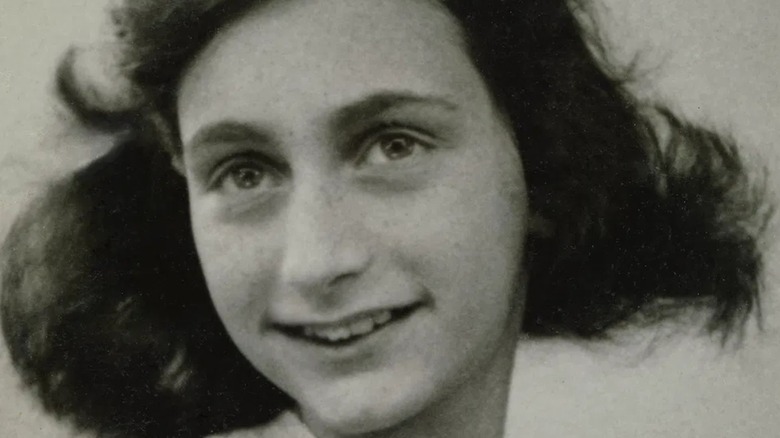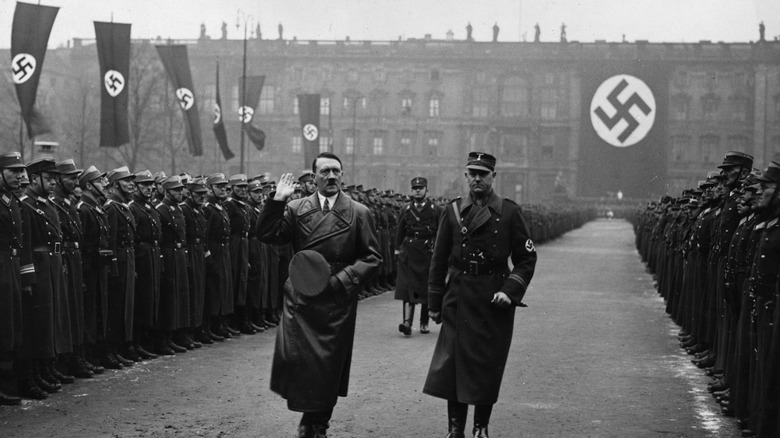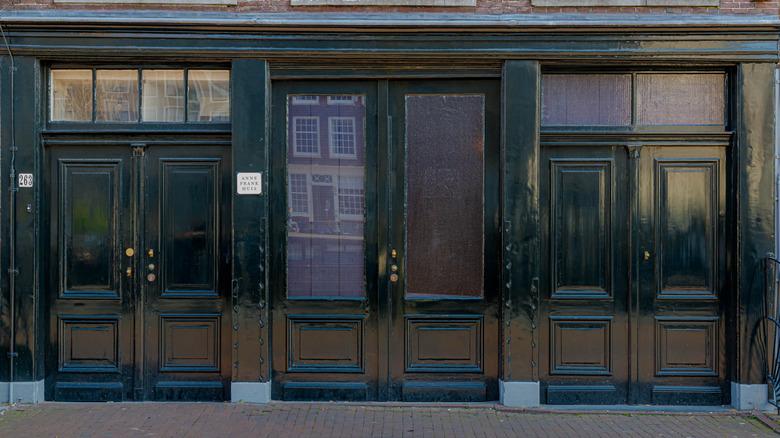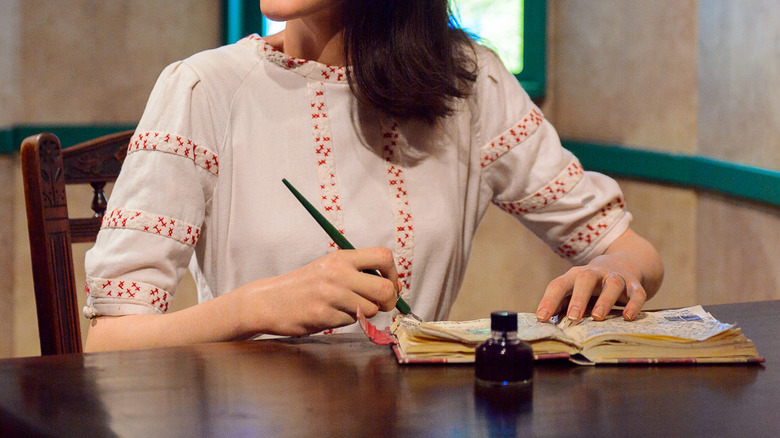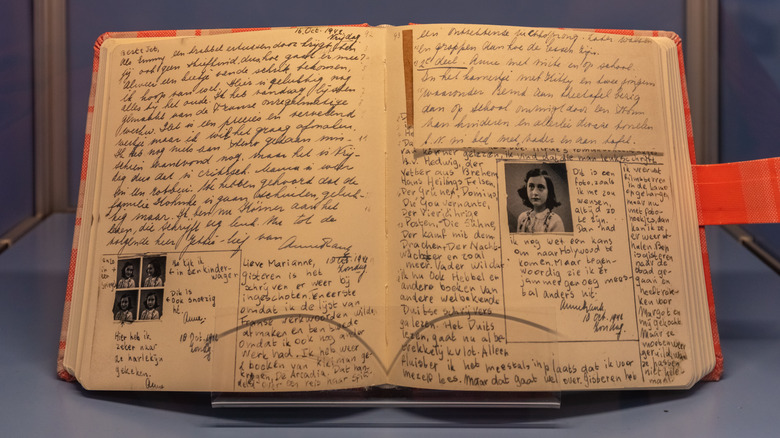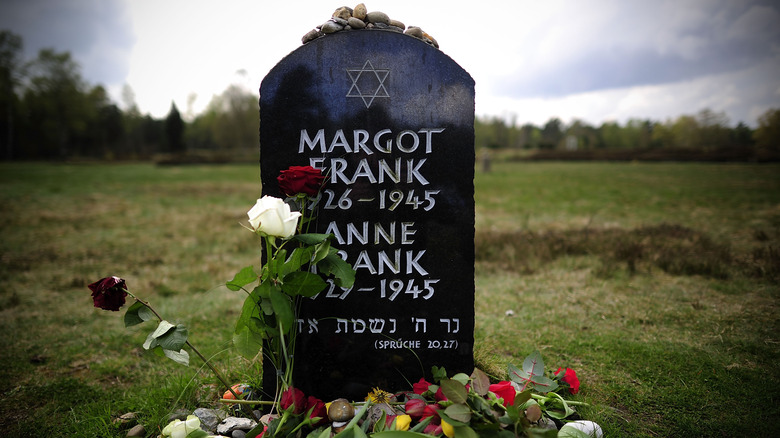The Real Reason Anne Frank Addressed Her Diary Entries To 'Kitty'
"Dearest Kitty — Today I have nothing but dismal and depressing news to report. Our many Jewish friends and acquaintances are being taken away in droves. The Gestapo is treating them very roughly and transporting them in cattle cars to Westerbork, the big camp in Drenthe to which they're sending all the Jews. Miep told us about someone who'd managed to escape from there. It must be terrible in Westerbork. The people get almost nothing to eat, much less to drink, as water is available only one hour a day, and there's only one toilet and sink for several thousand people" (excerpt from "The Diary of Young Girl" on Rhetorik).
Anne Frank wrote those words in her diary on October 9, 1942 when she was 13 years old. She goes on to describe rumors of Jews being gassed because it's "the quickest way to die," and talks about young men being shipped by "trainloads" to work in Germany. She complains about her mother not understanding her, and talks about her father being generous and loving. For over two years she wrote journal entries, tales, and even unfinished novels, from her "Secret Annex" hiding place in Amsterdam, as the Anne Frank House describes. On August 1, 1944, her entries stopped because she was discovered by Nazis. She died a year later.
Even though Anne was largely alone in her Secret Annex, she fashioned an imaginary friend to keep her company. "Dearest Kitty," she wrote, to this person she wished was real.
The black cloud of Nazism descends
Annelies Marie Frank was born on June 12, 1929, in Frankfurt, Germany, at the precise time when Germany's National Socialist German Worker's (Nazi) Party was coming into power. Germany had suffered a humiliating defeat in 1918 at the end of World War I. Their attempt to establish dominance on the European continent left them with seven million dead (via Facing History), and even more dangerously, wounded pride and a broken economy. The ultra short-lived Weimar Republic arose to fill the power gap following the war, but hyperinflation and the Great Depression in the U.S. — from 1929, the same year as Anne Frank's birth — saw the Weimar Republic all but collapse by 1933 (via History).
All of Germany's resentment, fear, and anger from World War I and its post-war period saw the rise of what's called the "stab-in-the-back" theory. As the Anne Frank House explains, many Germans at the time blamed their woes on dissent from within. They blamed any and every minority group possible for the disintegration of German society, particularly Jews.
Anne's family saw what was coming when the Nazis came into power in 1933. They were among those lucky enough — and wealthy enough — to be able to flee Germany. Because of Anne's father's business connections in Holland, they went to Amsterdam, as the United States Holocaust Memorial Museum explains. Anne stayed with her grandmother in Aachen, Germany, for a bit, and arrived in 1934. By 1940 the Nazis had taken Amsterdam.
Hiding in the Secret Annex
In July, 1942, Anne Frank and her family fled the Nazis by holing up in Prinsengracht 263, a building along one of Amsterdam's many canals that was owned by Anne's father Otto and used in his business. For two years Anne's family hid in the rear of the building in its annex, which along with a block of similar buildings faced away from the street to form a boxed-in, out-of-sight inner courtyard of trees (seen on the Anne Frank House website). Meanwhile, the literal front of the building became a figurative front for keeping the family safe, and was kept in operation by employees conducting business as usual selling herbs and spices.
Otto designed the annex along with his employee, Hermann van Pels. Pels and his family, who all knew each other, joined the Frank family in the annex along with an eighth person, Fritz Pfeffer. Entrance to the annex was concealed by the simplest of means: a bookshelf and map covering up a secret door, as depicted on an interactive 3D display on the Anne Frank House website. The bookcase, designed by friend of the family Johan Voskuijl, was a revolving contraption that could be opened from either side, and closed quickly in case soldiers raided the house. At the time, Nazis often raided houses looking for bicycles, of all things, and could show up at any moment. Without such a group effort, we would have never known about Anne Frank at all.
The fight for the desk
The Frank and Pels family, along with Fritz Pfeffer, settled into a daily routine in the annex, which had four cramped floors including an attic. They carried on as normally as possible within that space, terrified of being discovered and making as little noise as possible. Different people had different rooms, or sections of rooms, to operate as bedrooms, eating areas, a largish table for playing board games, and a shared toilet. The most critical period of silence was 8:30 a.m. to 9:00 a.m. when laborers worked nearby and no one was allowed to move, per the Anne Frank House. This is when Otto, Anne Frank's father, read Dickens to improve his English.
And of course, there was a desk that Anne used for her writings. Anne, a 12-to-14 year old girl during her time in the annex, was roommates with Pfeffer (a man as old as Anne's father), who insisted on using the desk to study English, Spanish, and Dutch because it was more important than Anne's writing. As the Anne Frank House continues, Anne wrote of him, "Stay calm, this fellow isn't worth worrying your head about!" Later, after her father intervened, Anne wrote, "Pfeffer looked very sullen, didn't talk to me for two days and made a point of sitting at the table from 5 to 5.30 anyway... childish, of course."
Meanwhile, food kept getting worse, and tensions mounted. Anne would often take to the attic to be alone, or sneak peeks outside using binoculars.
Letters to Kitty
So what would Anne Frank, a 12-to-14 year old girl, feel and think while hiding out away from the Nazis? What would she dream about? Without any friends, who would she talk to? This is where "Kitty" comes in, Anne's imaginary friend. Kitty fulfilled Anne's need for best friend, confidant, and confessor, and it's to Kitty that Anne addressed many of her diary entries.
As the Anne Frank House explains, Anne got the name "Kitty" from a book series she'd read by Dutch author Cissy van Marxveldt. The books, a series for young adults about the adventures of a girl named Joop ter Heul, featured the character Kitty Francken, whom Anne described as "'bright, cheerful, and funny." Anne started writing to Kitty in September, 1942, a couple months after her family hid away. She invented a whole suite of characters, including Pop, Phien, Conny, Lou, Marjan, Jettje, and Emmy, as well as all sorts of relationships, intrigue, and goings on between them. She even wrote to her fictional friends that "Jacqueline" – Jacqueline van Maarsen, an actual girl Anne had known – wasn't a part of their group.
Switzerland was Anne's go-to for a safe, beautiful place where she and Kitty could skate and play. The October 7, 1942 entry in her diary also describes a trip to Switzerland with her father, and the allowance he'd given her to buy new clothes, shoes, a pillow, and more (available on Rhetorik).
A testament to compassion
On 4 August 1944, between 10:30 and 11:00 a.m., Nazi soldiers finally discovered the Secret Annex at Prinsengracht 263, as the Anne Frank House describes. Friend of the family Miep Gies kept Anne's diary safe, and after the war ended, Anne's father Otto published a small batch of about 3,000 copies in Dutch in 1947 under the title "Het Achterhuis" ("The Secret Annex") (per the Anne Frank House). Otto was the only who'd survived. Anne and her mother Margot had died in the Bergen-Belsen concentration camp in 1945.
At present, Anne Frank's work has been translated into over 70 languages (per the Anne Frank House). In 2019, 75 years after her death, her incomplete novel "Dear Kitty" was published (per Deutsche Welle), as well as a graphic novel version of her diary (per the New York Times). It's safe to say that Anne Frank has become a legend and icon, in no small part due to her actual writing. She doesn't just put a human face on the Holocaust, she does so with a graceful charm and precocious wit.
Even so, it's important to remember that Anne was only one of 300,000 to 330,000 people hidden from Nazi Germany in the Netherlands during World War II. Anne's diary represents all of the unheard voices of the time, all the stories never written, and all the Kittys to whom young girls spoke.
